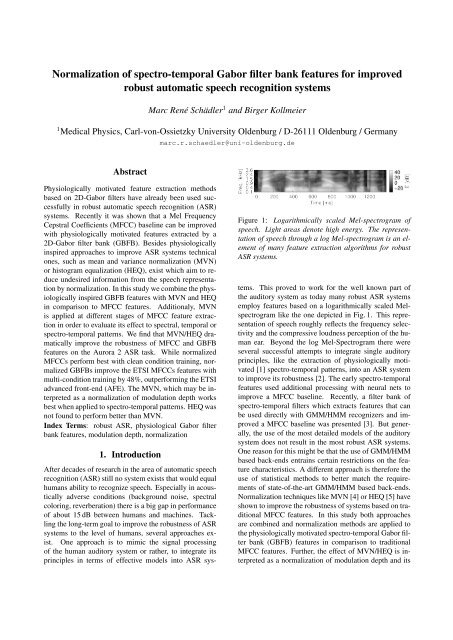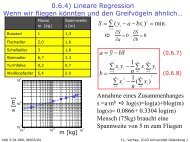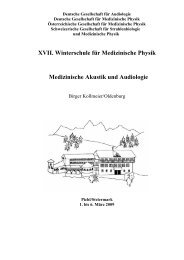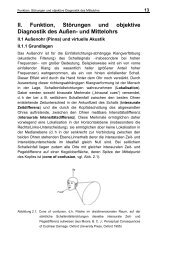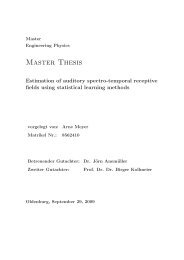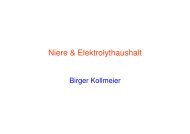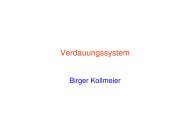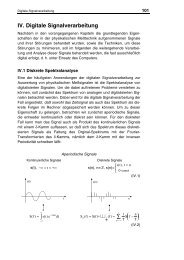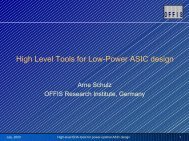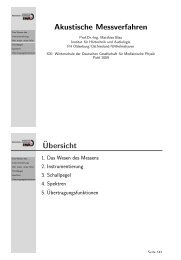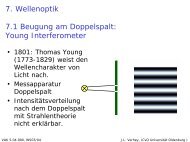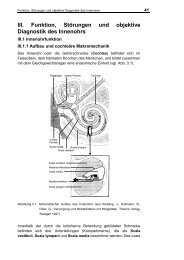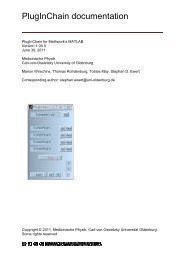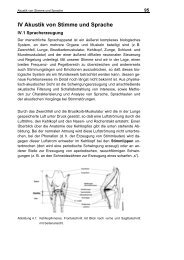Wed.P7c.05 Normalization of Spectro-Temporal Gabor Filter Bank ...
Wed.P7c.05 Normalization of Spectro-Temporal Gabor Filter Bank ...
Wed.P7c.05 Normalization of Spectro-Temporal Gabor Filter Bank ...
You also want an ePaper? Increase the reach of your titles
YUMPU automatically turns print PDFs into web optimized ePapers that Google loves.
<strong>Normalization</strong> <strong>of</strong> spectro-temporal <strong>Gabor</strong> filter bank features for improved<br />
robust automatic speech recognition systems<br />
Marc René Schädler 1 and Birger Kollmeier<br />
1 Medical Physics, Carl-von-Ossietzky University Oldenburg / D-26111 Oldenburg / Germany<br />
Abstract<br />
Physiologically motivated feature extraction methods<br />
based on 2D-<strong>Gabor</strong> filters have already been used successfully<br />
in robust automatic speech recognition (ASR)<br />
systems. Recently it was shown that a Mel Frequency<br />
Cepstral Coefficients (MFCC) baseline can be improved<br />
with physiologically motivated features extracted by a<br />
2D-<strong>Gabor</strong> filter bank (GBFB). Besides physiologically<br />
inspired approaches to improve ASR systems technical<br />
ones, such as mean and variance normalization (MVN)<br />
or histogram equalization (HEQ), exist which aim to reduce<br />
undesired information from the speech representation<br />
by normalization. In this study we combine the physiologically<br />
inspired GBFB features with MVN and HEQ<br />
in comparison to MFCC features. Additionaly, MVN<br />
is applied at different stages <strong>of</strong> MFCC feature extraction<br />
in order to evaluate its effect to spectral, temporal or<br />
spectro-temporal patterns. We find that MVN/HEQ dramatically<br />
improve the robustness <strong>of</strong> MFCC and GBFB<br />
features on the Aurora 2 ASR task. While normalized<br />
MFCCs perform best with clean condition training, normalized<br />
GBFBs improve the ETSI MFCCs features with<br />
multi-condition training by 48%, outperforming the ETSI<br />
advanced front-end (AFE). The MVN, which may be interpreted<br />
as a normalization <strong>of</strong> modulation depth works<br />
best when applied to spectro-temporal patterns. HEQ was<br />
not found to perform better than MVN.<br />
Index Terms: robust ASR, physiological <strong>Gabor</strong> filter<br />
bank features, modulation depth, normalization<br />
1. Introduction<br />
After decades <strong>of</strong> research in the area <strong>of</strong> automatic speech<br />
recognition (ASR) still no system exists that would equal<br />
humans ability to recognize speech. Especially in acoustically<br />
adverse conditions (background noise, spectral<br />
coloring, reverberation) there is a big gap in performance<br />
<strong>of</strong> about 15 dB between humans and machines. Tackling<br />
the long-term goal to improve the robustness <strong>of</strong> ASR<br />
systems to the level <strong>of</strong> humans, several approaches exist.<br />
One approach is to mimic the signal processing<br />
<strong>of</strong> the human auditory system or rather, to integrate its<br />
principles in terms <strong>of</strong> effective models into ASR sys-<br />
marc.r.schaedler@uni-oldenburg.de<br />
Figure 1: Logarithmically scaled Mel-spectrogram <strong>of</strong><br />
speech. Light areas denote high energy. The representation<br />
<strong>of</strong> speech through a log Mel-spectrogram is an element<br />
<strong>of</strong> many feature extraction algorithms for robust<br />
ASR systems.<br />
tems. This proved to work for the well known part <strong>of</strong><br />
the auditory system as today many robust ASR systems<br />
employ features based on a logarithmically scaled Melspectrogram<br />
like the one depicted in Fig. 1. This representation<br />
<strong>of</strong> speech roughly reflects the frequency selectivity<br />
and the compressive loudness perception <strong>of</strong> the human<br />
ear. Beyond the log Mel-<strong>Spectro</strong>gram there were<br />
several successful attempts to integrate single auditory<br />
principles, like the extraction <strong>of</strong> physiologically motivated<br />
[1] spectro-temporal patterns, into an ASR system<br />
to improve its robustness [2]. The early spectro-temporal<br />
features used additional processing with neural nets to<br />
improve a MFCC baseline. Recently, a filter bank <strong>of</strong><br />
spectro-temporal filters which extracts features that can<br />
be used directly with GMM/HMM recognizers and improved<br />
a MFCC baseline was presented [3]. But generally,<br />
the use <strong>of</strong> the most detailed models <strong>of</strong> the auditory<br />
system does not result in the most robust ASR systems.<br />
One reason for this might be that the use <strong>of</strong> GMM/HMM<br />
based back-ends entrains certain restrictions on the feature<br />
characteristics. A different approach is therefore the<br />
use <strong>of</strong> statistical methods to better match the requirements<br />
<strong>of</strong> state-<strong>of</strong>-the-art GMM/HMM based back-ends.<br />
<strong>Normalization</strong> techniques like MVN [4] or HEQ [5] have<br />
shown to improve the robustness <strong>of</strong> systems based on traditional<br />
MFCC features. In this study both approaches<br />
are combined and normalization methods are applied to<br />
the physiologically motivated spectro-temporal <strong>Gabor</strong> filter<br />
bank (GBFB) features in comparison to traditional<br />
MFCC features. Further, the effect <strong>of</strong> MVN/HEQ is interpreted<br />
as a normalization <strong>of</strong> modulation depth and its
Figure 2: Left panel: Effective spectro-temporal patterns<br />
<strong>of</strong> combined traditional spectral DCT and temporal<br />
∆&∆∆ processing. Right panel: The 41 2D-<strong>Gabor</strong> filters<br />
that are used for feature extraction with the <strong>Gabor</strong><br />
filter bank. The patterns are scaled and their real spectral<br />
extension is the same as <strong>of</strong> the MFCC-DD patterns<br />
in the left panel.<br />
effect on temporal, spectral, and spectro-temporal patterns<br />
is investigated.<br />
2. Methods<br />
2.1. <strong>Gabor</strong> filter bank features<br />
The <strong>Gabor</strong> filter bank (GBFB) )features are based on a<br />
log Mel-spectrogram with 23 Mel-bands between 64 Hz<br />
and 4 kHz, 10 ms window shift, and 25 ms window<br />
length. An examplary log Mel-spectrogram is depicted<br />
in Fig. 1. While for the extraction <strong>of</strong> MFCCs with<br />
∆&∆∆ this spectro-temporal representation is processed<br />
spectrally with a DCT and temporally with slope-filters,<br />
GBFB features are extracted with 2D-<strong>Gabor</strong> filters that<br />
perform a simultaneous spectral and temporal processing.<br />
Fig. 2 depicts the relation <strong>of</strong> the spectro-temporal<br />
2D-<strong>Gabor</strong> filters and the effective MFCC-DD spectrotemporal<br />
patterns. The outer product <strong>of</strong> a DCT base function<br />
and a Delta base function gives the effective spectrotemporal<br />
pattern that the corresponding MFCC-DD dimension<br />
encodes. The GBFB feature extraction is illustrated<br />
in Fig. 3. First, spectro-temporal patterns are extracted<br />
by 2D-convolving the 2D-<strong>Gabor</strong> filter functions<br />
with the log Mel-spectrogram. A subsequent selection <strong>of</strong><br />
representative channels by critically sampling the filtered<br />
log Mel-spectrograms limits the systematical correlation<br />
<strong>of</strong> the feature dimensions. Each 2D-<strong>Gabor</strong> filter extracts<br />
patterns <strong>of</strong> a pair <strong>of</strong> a spectral and a temporal modulation<br />
frequency. These features were shown to improve the robustness<br />
<strong>of</strong> a MFCC baseline system when fed directly<br />
into an GMM/HMM recognizer [3]. The range <strong>of</strong> modu-<br />
Figure 4: Illustration <strong>of</strong> mean and variance normalization<br />
and histogram equalization <strong>of</strong> the first MFCC values<br />
for a speech signal in different acoustic contexts.<br />
lation frequencies covered is about 6 to 25 Hz and 0.03 to<br />
0.25 cycles<br />
Mel-band . Some properties <strong>of</strong> the GBFB features are<br />
compared with those <strong>of</strong> MFCC features in Tab. 1. The<br />
MFCC-DD processing can be described by separate spectral<br />
and temporal operations, while the GBFB processing<br />
cannot.<br />
Table 1: Properties <strong>of</strong> MFCCs and GBFBs compared<br />
Feature spectral temporal separable dim.<br />
MFCC-DD DCT ∆&∆∆ yes 39<br />
GBFB <strong>Gabor</strong> <strong>Gabor</strong> no 311<br />
2.2. <strong>Normalization</strong> <strong>of</strong> feature value statistics<br />
It has been shown that the robustness <strong>of</strong> an ASR system<br />
with MFCC features can be increased by removing the<br />
mean value and normalizing the variance <strong>of</strong> each feature<br />
dimension [4]. This processing is called mean and variance<br />
normalization (MVN) and normalizes the first and<br />
the second moments <strong>of</strong> the feature value distributions.<br />
An extension to MVN is mapping the feature values to<br />
a specific reference distribution [5]. This processing is<br />
called histogram equalization (HEQ) and normalizes all<br />
moments <strong>of</strong> the feature value distributions. The effect <strong>of</strong><br />
MVN and HEQ on the first (not zeroth) MFCC is illustrated<br />
in Fig. 4. A spectral coloring (eg. preemphasis) <strong>of</strong><br />
a speech signal leads to a systematic changes in the log<br />
Mel-spectrogram and consequently to a change <strong>of</strong> the derived<br />
features (cf. <strong>of</strong>fset/mean value in Fig. 4 colored).<br />
Likewise, additive noise or reverberation result in a reduction<br />
<strong>of</strong> the dynamic range by filling up the ”valleys”<br />
<strong>of</strong> the log Mel-spectrogram, which may be interpreted<br />
as a reduction <strong>of</strong> modulation depth (cf. scale/variance<br />
in Fig. 4 noisy). Applying MVN/HEQ to MFCC/GBFB<br />
features counteracts the influence <strong>of</strong> the most common<br />
sources <strong>of</strong> variability in noisy speech by normalizing the<br />
modulation depth, because the feature values scale lin-
Figure 3: Illustration <strong>of</strong> the <strong>Gabor</strong> filter bank feature extraction. n: temporal index; k: spectral index; ω: modulation<br />
frequencies. The input log Mel-spectrogram is filtered with each <strong>of</strong> the 41 filters <strong>of</strong> the <strong>Gabor</strong> filter bank. Representative<br />
channels <strong>of</strong> the filter outputs are selected and concatenated. The 311-dimensional output is used as feature vector.<br />
early with it. The recognition performance <strong>of</strong> GBFB and<br />
MFCC features is evaluated with and without MVN and<br />
HEQ.<br />
2.3. Recognition experiment and baseline<br />
The effect <strong>of</strong> the different front-ends on the robustness <strong>of</strong><br />
an ASR system is evaluated within the Aurora 2 framework<br />
[6]. The task is the recognition <strong>of</strong> English connected<br />
digits which are contaminated with eight different<br />
everyday background noises from 20 dB to -5 dB. The<br />
framework provides speech data for training and testing<br />
as well as a GMM/HMM classifier and trainings rules. A<br />
reference setup defines whole-word left-to-right HMMs<br />
with 16 states, 3 mixtures per state, and without skips<br />
over states. The back-end is not modified and used with<br />
the same parameters as in the reference. Two different<br />
training conditions exist. For clean training only utterances<br />
without added noise are used, while for multi training<br />
utterances with and without added noise are used.<br />
Although only four noise types that occur in the testing<br />
data are also included in multi training data, it allows the<br />
recognizer to learn the reliability <strong>of</strong> feature patterns in<br />
noise. As reference features the first 13 MFCCs with first<br />
and second order discrete temporal derivative (∆&∆∆)<br />
are used, resulting in 39-dimensional MFCC-DD features.<br />
Additionally the baseline results for ETSI MFCC<br />
[7] and ETSI Advanced Front-End (AFE) [8] features are<br />
reported. The word recognition accuracies are compared<br />
at signal-to-noise ratios (SNR) from 20 to -5 dB.<br />
2.4. Spectral and temporal contribution<br />
With the aim <strong>of</strong> evaluating the effect <strong>of</strong> normalizing only<br />
spectral, only temporal, or spectro-temporal patterns, the<br />
separability <strong>of</strong> spectral and the temporal processing with<br />
MFCC-DD features is exploited The normalization (N) is<br />
applied at the following stages <strong>of</strong> MFCC-DD feature calculation:<br />
MFCC-N-DD, MFCC-DD-N, DD-N-MFCC.<br />
With MFCC-N-DD features, spectral patterns are integrated<br />
by the DCT before normalization. With DD-N-<br />
MFCC features, short term temporal patterns are integrated<br />
by the ∆&∆∆ processing before normalization.<br />
And with MFCC-DD-N features, spectral and short term<br />
Figure 5: Word recognition accuracies for GBFB and<br />
MFCC-DD feature with and without mean and variance<br />
normalization (N) at different test signal to noise ratios<br />
and training styles.<br />
temporal patterns are integrated before normalization.<br />
The recognition performance <strong>of</strong> the differently normalized<br />
features is evaluated.<br />
3. Results<br />
3.1. Normalized GBFB features<br />
Average word recognition accuracies (WRA) for GBFB<br />
and MFCC features with and without MVN are reported<br />
in Fig. 5. With clean condition training MVN dramatically<br />
improves the robustness <strong>of</strong> MFCCs by 5-7 dB over<br />
a wide range <strong>of</strong> WRAs (50% to 95%). The improvements<br />
for GBFBs with 2-3 dB are smaller, but they perform<br />
about 3 dB better without MVN. Thus, MFCCs perform<br />
about 1 dB better than GBFBs at low SNRs, but cannot<br />
improve the highly optimized ETSI AFE baseline. However,<br />
GBFB features outperform all features when testing<br />
on clean data. In terms <strong>of</strong> average relative improvement<br />
over SNRs from 20 dB to 0 dB, MFCCs with MVN improve<br />
the WRA <strong>of</strong> the ETSI MFCC baseline by 58% on,<br />
while GBFBs with MVN improve the baseline by 54%.<br />
With multi condition training MVN improves the performance<br />
<strong>of</strong> MFCCs almost independently <strong>of</strong> the SNR by<br />
about 2-3 dB. For GBFB features the improvements are<br />
with 2.5 dB at low SNRs and up to 6 dB at high SNRs
Figure 6: Word recognition accuracies for MFCC-<br />
DD features with and without mean and variance normalization<br />
<strong>of</strong> spectral (MFCC-N-DD), temporal(DD-N-<br />
MFCC), and spectro-temporal (MFCC-DD-N) patterns<br />
at different signal to noise ratios for clean and multi style<br />
training.<br />
more pronounced. In terms <strong>of</strong> average relative improvement<br />
over SNRs from 20 dB to 0 dB, MFCCs with MVN<br />
improve the WRA <strong>of</strong> the ETSI MFCC baseline by 37%,<br />
while GBFBs with MVN improve the baseline by 48%.<br />
GBFB features outperform all other features, including<br />
ETSI AFE, in every noisy testing condition. The the improvements<br />
with HEQ were found to be similar to the improvements<br />
with MVN within a range <strong>of</strong> ±1 dB and are<br />
therefore omitted. The very high recognition scores for<br />
clean testing data with clean condition training, as well<br />
as for high SNRs with multi condition training (which<br />
contains speech data at {∞, 20, 15, 10, 5} dB SNR) indicate<br />
a certain sensitivity <strong>of</strong> GBFB features to mismatched<br />
SNR conditions. Possibly, the 311-dimensional<br />
GBFB features encode more precise information about<br />
the speech signal than the 39-dimensional MFCC features<br />
which results in a higher sensitivity to the SNR. This<br />
finding puts the one-model-for-all-SNRs approach into<br />
question, as speech at 0 dB SNR and speech at 20 dB SNR<br />
have quite different characteristics. If the hypothesis<br />
holds, than GBFB features with MVN should perform<br />
even better in context-dependent models, which should<br />
be evaluated in future experiments.<br />
3.2. Spectral vs. temporal normalization<br />
Average word recognition accuracies (WRA) for MFCC<br />
features with and without MVN <strong>of</strong> spectral, temporal,<br />
and spectro-temporal patterns are depicted in Fig. 6.<br />
Normalizing the output after the temporal processing and<br />
before the spectral processing results in worse performance<br />
than without normalization, with an exception at<br />
very low SNRs with multi condition training. The MVN<br />
effectively normalizes all Mel-bands to have the same<br />
energy and the same modulation depth which seems to<br />
accompanied by a loss <strong>of</strong> information that is relevant<br />
for robust ASR. Normalizing the output after the spectral<br />
processing and before the temporal processing results<br />
in important improvements, but the best performance is<br />
achieved by normalizing after the spectral and temporal<br />
processing. This indicates that spectro-temporal patterns<br />
are best extracted from an unprocessed spectro-temporal<br />
representation and normalization is best performed after<br />
spectral and temporal integration.<br />
4. Conclusions<br />
The most important findings <strong>of</strong> this work can be summarized<br />
as follows:<br />
• <strong>Normalization</strong> increases the robustness <strong>of</strong> physiologically<br />
motivated spectro-temporal <strong>Gabor</strong> filter<br />
bank features by 2.5-5 dB SNR on a digit recognition<br />
task, outperforming ETSI AFE features with<br />
multi-style training.<br />
• <strong>Normalization</strong> <strong>of</strong> separable spectro-temporal patterns<br />
was found to be best applied after spectral and<br />
temporal integration.<br />
• Normalized <strong>Gabor</strong> filter bank features seem work<br />
well in matched signal to noise ratio conditions,<br />
which should be further investigated with SNRdependend<br />
models.<br />
5. Acknowledgements<br />
This work is funded by DFG SFB/TRR 31 ”The active<br />
auditory system”.<br />
6. References<br />
[1] A. Qiu, C. Schreiner, and M. Escabi, “<strong>Gabor</strong> analysis <strong>of</strong> auditory<br />
midbrain receptive fields: spectro-temporal and binaural composition,”<br />
J. Neurophysiology, vol. 90, no. 1, pp. 456–476, 2003.<br />
[2] M. Kleinschmidt and D. Gelbart, “Improving word accuracy with<br />
<strong>Gabor</strong> feature extraction,” in Proc. <strong>of</strong> Interspeech 2002, 2002, pp.<br />
25–28.<br />
[3] M. Schädler, B. Meyer, and B. Kollmeier, “<strong>Spectro</strong>-temporal modulation<br />
subspace-spanning filter bank features for robust automatic<br />
speech recognition,” J. Acoust. Soc. Am., vol. accepted, 2012.<br />
[4] O. Viikki and K. Laurila, “Cepstral domain segmental feature vector<br />
normalization for noise robust speech recognition,” Speech<br />
Communication, vol. 25, no. 1-3, pp. 133–147, 1998.<br />
[5] A. De La Torre, A. Peinado, J. Segura, J. Pérez-Córdoba,<br />
M. Benítez, and A. Rubio, “Histogram equalization <strong>of</strong> speech representation<br />
for robust speech recognition,” Speech and Audio Processing,<br />
IEEE Transactions on, vol. 13, no. 3, pp. 355–366, 2005.<br />
[6] D. Pearce and H. Hirsch, “The Aurora experimental framework for<br />
the performance evaluation <strong>of</strong> speech recognition systems under<br />
noisy conditions,” in Proc. <strong>of</strong> ICSLP 2000, vol. 4, 2000, pp. 29–32.<br />
[7] ETSI standards document, “201 108 v. 1.1.3, speech processing<br />
transmission and quality aspects (stq); distributed speech recognition;<br />
front-end feature extraction algorithm; compression algorithms,”<br />
European Telecommunications Standards Institute, 2003.<br />
[8] ——, “202 050 v. 1.1.5, speech processing transmission and quality<br />
aspects (stq); distributed speech recognition; advanced front-end<br />
feature extraction algorithm; compression algorithms,” European<br />
Telecommunications Standards Institute, 2007.


